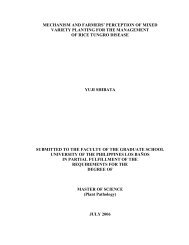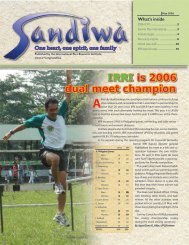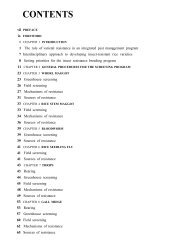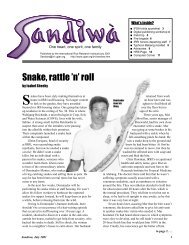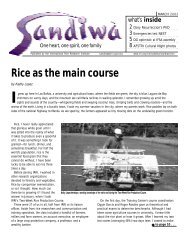Untitled - International Rice Research Institute
Untitled - International Rice Research Institute
Untitled - International Rice Research Institute
Create successful ePaper yourself
Turn your PDF publications into a flip-book with our unique Google optimized e-Paper software.
moderately fast and attain a 4.32-cm diam in 5 d.<br />
They are slightly zonated, thickly felted, and grayish,<br />
becoming light outward. On the reverse side of the<br />
agar plate, the colony is azonated, black, and lighter<br />
outward. At 21 °C under alternating 12-h NUV light<br />
and 12-h darkness, colonies grow moderately fast<br />
and attain a 4.14-cm diam in 5 d. They are azonated,<br />
becoming markedly zonated outward, felted, yellowish<br />
to greenish gray, with a 0.5-cm sterile white margin.<br />
On the reverse side of the agar plate, the colony<br />
appears zonated and black and light outward. At 28<br />
°C under alternating 12-h light and 12-h darkness,<br />
colonies grow moderately fast and attain a 4.33-cm<br />
diam in 5 d. They are zonated, felted, and greenish<br />
gray. On the reverse side of the agar plate, the colony<br />
is zonated and black and yellowish brown outward.<br />
Colonies on potato sucrose agar (PSA) incubated<br />
at ART (28–30 °C) grow moderately fast and<br />
attain a 4.18-cm diam in 5 d. They are deeply felted,<br />
zonated with an even margin, and gray. The colony<br />
appears zonated and black on the reverse side of the<br />
agar plate. At 21 °C under alternating 12-h NUV and<br />
12-h darkness, colonies grow moderately fast and<br />
attain a 4.36-cm diam in 5 d. They are slightly zonated<br />
with a light gray submerged advancing margin,<br />
felted, and dark greenish gray. The colony appears<br />
slightly zonated, black, and lighter outward on the<br />
reverse side of the agar plate. At 28 °C under alternating<br />
12-h light and 12-h darkness, colonies grow<br />
moderately fast and attain a 4.06-cm diam in 5 d.<br />
They are zonated, felted with a sinuate margin, yellowish<br />
to greenish gray, and lighter at the margins.<br />
The colony appears zonated and black, and yellowish<br />
brown outward on the reverse side of the agar<br />
plate.<br />
Colonies on malt extract agar (MEA) incubated<br />
at ART (28–30 °C) grow moderately fast and attain a<br />
4.53-cm diam in 5 d. They are zonated, felted, and<br />
light gray to gray. The colony appears zonated and<br />
black on the reverse side of the agar plate. At 21 °C<br />
under alternating 12-h NUV and 12-h darkness, colonies<br />
grow moderately fast and attain a 4.47-cm diam<br />
in 5 d. They are azonated, becoming markedly zonated<br />
outward, and white to yellowish gray and becoming<br />
gray outward. The colony appears zonated<br />
and black with a light gray margin on the reverse side<br />
of the agar plate. At 28 °C under alternating 12-h<br />
fluorescent light and 12-h darkness, colonies grow<br />
moderately fast and attain a 4.90-cm diam in 5 d.<br />
They are zonated, felted, and greenish gray, becoming<br />
gray at the margins. The colony appears slightly<br />
zonated and black on the reverse side of the agar<br />
plate.<br />
Bipolaris oryzae (Breda de Haan) Shoem.<br />
syn. Drechslera oryzae (Breda de Haan) Subram. & Jain<br />
Helminsthosporium oryzae<br />
teleomorph: Cochliobolus miyabeanus (Ito & Kurib)<br />
Disease caused: brown spot (brown leaf spot or<br />
sesame leaf spot)<br />
Helminsthosporium blight<br />
a. Symptoms<br />
On leaves—small and circular dark brown or<br />
purple brown spots eventually becoming oval<br />
(similar to size and shape of sesame seeds) and<br />
brown spots with gray to whitish centers, evenly<br />
distributed over the leaf surface; spots much<br />
larger on susceptible cultivars. A halo relating to<br />
toxin produced by the pathogen often surrounds<br />
the lesions.<br />
On glumes—black or brown spots covering the<br />
entire surface of the seed in severe cases. Under<br />
favorable environments, conidiophore and conidia<br />
may develop on the spots, giving a velvety appearance.<br />
Coleoptile—small, circular, or oval brown spots.<br />
b. Occurrence/distribution<br />
Brown spot is distributed worldwide and reported<br />
in all rice-growing countries in Asia, America,<br />
and Africa (Fig. 9). It is more prevalent in rainfed<br />
lowlands and uplands or under situations with abnormal<br />
or poor soil conditions.<br />
c. Disease history<br />
This fungus was first described in 1900 and<br />
named as Helminthosporium oryzae. In Japan, the<br />
teleomorph was found in culture and was named<br />
Ophiobolus miyabeanus. However, Drechsler<br />
decided it belonged to Cochliobolus and renamed<br />
17



